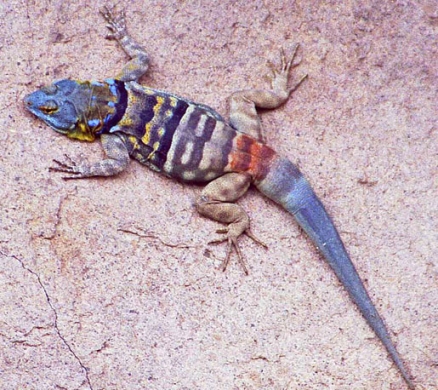Sierra de la Laguna pine-oak forests
The Sierra de la Laguna pine-oak forest is a mountainous ecoregion which rises from the arid Baja California Sur, creating islands of unique vegetative communities. There are approximately 694 plant species, approximately 85 of which are endemic to this ecoregion. Overall species richness is low to moderate, with a total of only 231 vertebrate taxa, for example. The ecoregion is classified to be in the Tropical and Subtropical Coniferous Forests biome. Much of the pine-oak association remains intact due to the inaccessibility of the rugged and inaccessible terrain; however, overgrazing occurs in some parts of the ecoregion, and faunal predators are often killed by local ranchers to protect livestock.
Location and general depiction
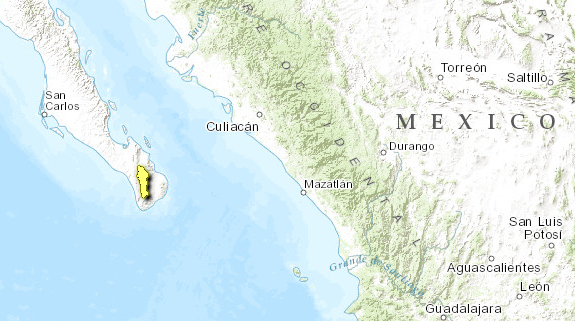 Image Source: World Wildlife Fund
Image Source: World Wildlife Fund
This ecoregion is contained in a larger area known as the Cape Region, and constitutes the southernmost part of the Baja California Peninsula. The area is literally an island of vegetation due to its origin as an isolated land area, ten million years ago (during the Miocene), which later joined the more desert-like peninsula. A vast complex of granitic mountains, running southward from the Gulf of California to the Pacific shapes the region. These mountains are dissected by lWF numerous valleys and canyons, and surrounded by vast plateaus.
The topographical features and geological events that gave rise to this particular region are responsible for the diversity of climates and vegetation in the same area. The highest strata of mountains, situated at 1600 to 2000 metres (m) in elevation, are composed of pine-oak forests that transform into oak-pine forests (1200 m) and oak forests (800 m) as elevation decreases. The climate is temperate sub-humid with summer rains and occasional winter rains.
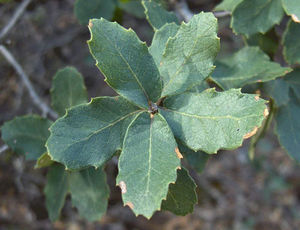 Leaves of Arizona White Oak. Source: Homer Edward Price These pine-oak forests constitute the wettest portions in the state of Baja California Sur (760 millimetres of precipitation annually). Slight variations in climatic conditions make up three different vegetation assemblages in the temperate forest. Pine forests at the highest elevations are dominated by Pinus cembroides ssp. lagunae, and understory taxa such as Muhlenbergia spp. and Festuca spp. Pine-oak forests dominated by associations of Pinus cembroides subsp. lagunae with Quercus devia, Arbutus peninsularis, and Quercus tuberculata, and a variety of trees of smaller stature such as Calliandra peninsularis and Mimosa tricephala, with associated shrubs to complement the landscape. There are a number of special status taxa that are found in the San Lucan xeric scrub, denoted variously as Lower Risk/Least Concern (LR/LC), Near Threatened (NT), Vulnerable (VU), Endangered (EN), or Critically Endangered (CR).
Leaves of Arizona White Oak. Source: Homer Edward Price These pine-oak forests constitute the wettest portions in the state of Baja California Sur (760 millimetres of precipitation annually). Slight variations in climatic conditions make up three different vegetation assemblages in the temperate forest. Pine forests at the highest elevations are dominated by Pinus cembroides ssp. lagunae, and understory taxa such as Muhlenbergia spp. and Festuca spp. Pine-oak forests dominated by associations of Pinus cembroides subsp. lagunae with Quercus devia, Arbutus peninsularis, and Quercus tuberculata, and a variety of trees of smaller stature such as Calliandra peninsularis and Mimosa tricephala, with associated shrubs to complement the landscape. There are a number of special status taxa that are found in the San Lucan xeric scrub, denoted variously as Lower Risk/Least Concern (LR/LC), Near Threatened (NT), Vulnerable (VU), Endangered (EN), or Critically Endangered (CR).
Oak forests here resemble subtropical forest, and they are inhabited by species such as Arizona White Oak (Quercus arizonica), with virtually no pine taxa. Some shrubs and smaller trees are strongly associated with this vegetative community, including Hopseed Bush (Dodonaea viscosa), Sideroxylon peninsulare VU, and Buddleja amplexicaulis. There are no epiphytes in this ecoregion; however there is an extraordinary abundance of mosses and lichens.
Biodiversity characteristics
The Sierra de la Laguna pine-oak forest is amountainous ecoregion which rises from the arid Baja California Sur, creating islands of unique vegetative communities. There are approximately 694 plant species, approximately 85 of which are endemic to this ecoregion. Much of the pine-oak remains intact due to the inaccessibility of the rugged terrain; however, overgrazing occurs in some areas and faunal predators are killed to protect livestock.
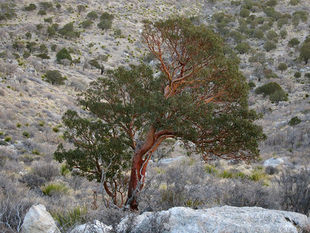 Texas Madrone tree. Source: Miguel Vieira/ EoL The prehistoric and present isolation of Sierra de la Laguna from the rest of the Baja Peninsula has played a major role in producing an extraordinary array of plant species, including Pinus cembroides ssp. lagunae. Pine-oak forests are the only temperate forests in the state of Baja California Sur, which makes these forests particularly significant in terms of the biological diversity that is extant here. Generally pine-oak forests exhibit high numbers of vertebrate species that have restricted distribution. The ecoregion exhibits approximately 694 species of plants, 85 of which are endemic to the Sierra de la Laguna. Three of the plant species that represent the main elements of the vegetative associations include Pinus cembroides subsp. lagunae, Texas Madrone (Arbutus xalapensis LR/LC) and Sideroxylon peninsulare.
Texas Madrone tree. Source: Miguel Vieira/ EoL The prehistoric and present isolation of Sierra de la Laguna from the rest of the Baja Peninsula has played a major role in producing an extraordinary array of plant species, including Pinus cembroides ssp. lagunae. Pine-oak forests are the only temperate forests in the state of Baja California Sur, which makes these forests particularly significant in terms of the biological diversity that is extant here. Generally pine-oak forests exhibit high numbers of vertebrate species that have restricted distribution. The ecoregion exhibits approximately 694 species of plants, 85 of which are endemic to the Sierra de la Laguna. Three of the plant species that represent the main elements of the vegetative associations include Pinus cembroides subsp. lagunae, Texas Madrone (Arbutus xalapensis LR/LC) and Sideroxylon peninsulare.
There are 108 species of arthropods, two amphibiantaxa, 27 reptiles, 74 avian species and 30 mammal species. The herpetofauna adapted to this habitat includes 20 percent of the 48 recorded species that are endemic to the Cape Region.
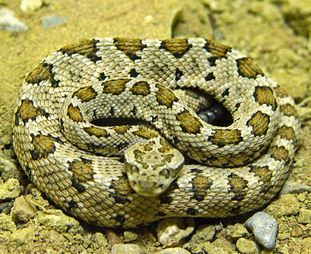 Baja California Rattlesnake. Creative Commons Reptiles
Baja California Rattlesnake. Creative Commons Reptiles
Some of the endemic reptiles are the Southern Alligator Lizard (Elgaria multicarinata) and the Yucca Night Lizard (Xantusia vigilis). Other reptilian taxa found in the Sierra de la Laguna pine-oak forests include the Baja California Rock Lizard (Petrosaurus thalassinus),Baja California Rattlesnake (Crotalus enyo) and the Baja California Brush Lizard (Urosaurus nigricaudus).
Amphibians
Only two amphibian taxa are found in the Sierra de la Laguna pine-oak forests. The Red-spotted Toad (Anaxyrus punctatus) is one anuran found here. The widely distributed California Chorus Frog (Pseudacris cadaverina) is another resident of the ecoregion. One other anuran, Pseudacris regilla, was previously recognized in the ecoregion, but erecent DNA analysis has rendered this taxon of unclear distribution.
Birdlife
The avifauna inhabiting these pine-oak forests is important because half of the bird species breeding at Sierra de la Laguna only utilize pine-oak forests as breeding habitat. The endemic Baja Pygmy Owl (Glaucidium gnoma hoskinsii), along with the White-winged Dove (Zenaida asiatica) and Golden Eagle (Aquila chrysaetos) are only a few of the avian species found in this ecoregion. Other notable birds in this and the Gulf of California xeric scrub ecoregion include the Xantus's Hummingbird (Hylocharis xantusii) and the endangered Peninsular Yellowthroat (Geothlypis beldingi EN).
Mammals
Of the approximately 30 mammalian species of mammals present, one of them (an endemic bat) lives only in pine-oak forests. The level of endemism is high, and this is well demonstrated by the proportion of endemic species with respect to total recorded species. More than ten percent of the mammalian species found at Sierra de la Laguna are endemic. One notable mammal found along the far west coast, including California and Baja, is the Ornate Shrew (Sorex ornatus). There are several threatened mammals found in the Sierra de la Laguna pine-oak forests, including: the Mexican Long-tongued Bat (Choeronycteris mexicana NT). The isolation of this region has contributed to the scarcity of predators, and to the poor competitive ability of some animals. Rodents and lagomorphs are virtually absent from the region, this fact favors the abundance of animals that would otherwise be abated by direct competition, as exemplified by the Acorn Woodpecker (Melanerpes formicivorus).
Ecological status
Large areas of habitat still remain intact, as the topographical features render this ecoregion difficult to explore or exploit. Portions of the Sierra de la Laguna dry forest ecoregion still remain intact; however, accessible areas are being converted for cattle grazing. There is still no recognizable fragmentation of the habitat, mostly due to the reduced exploitation of forest resources. In June 1994, the region was established as a Protected Natural Area (PNA), with pine-oak forests and subtropical dry forest as the key areas for protection. The fragile nature of this region requires legal protection over a long period, in order to prevent it from disturbances caused by human overpopulation and exploitation of forest resources involving livestock overgrazing.
Ecological threat profile
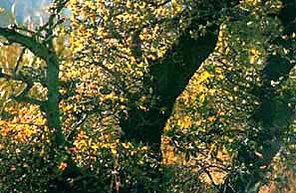 Sierra La Laguna Bio. Res., Baja, Mexico. Source: Gerardo Ceballos/SEMARNAP
Sierra La Laguna Bio. Res., Baja, Mexico. Source: Gerardo Ceballos/SEMARNAP
Native villagers often kill predatory wildlife they consider a threat to their domestic animals. If this practise continues, it could alter the natural processes maintaining biodiversity in the area. Although human disturbance to the natural environment in the Sierra de la Laguna has been minimal, any uncontrolled perturbation to this fragile ecosystem could create an imbalance, which could ultimately cause the disappearance of a wide array of evolutionary phenomena that has produced a unique vegetation assemblage in the midst of an enormous desert.
Justification of ecoregion delineation
These montane pine-oak forests of the southern Baja Peninsula of Mexico are isolated from all other similar [[habitat]s] and are host to a number of endemic species. Linework for this ecoregion follows the Instituto Nacional de Estadística Geografía e Informática (INEGI) current landcover maps, encompassing all "oak and pine forest" classification within the Sierra de la Laguna region, as well as portions of "low deciduous forest", "matorral", and agricultural activities which fall within these parameters. Classification and justification follow Rzedowski. Linework was reviewed by experts during ecoregional priority setting workshops in Mexico.
See also
References
- S. Alvarez-Cárdenas, P. Gallina-Tessaro, and A. González. 1988. Herpetofauna. Pages 167-184 in La Sierra de la Laguna de Baja California Sur L. Arriaga, and A. Ortega, editors, Centro de Investigaciones Biológicas de Baja California Sur, México.
- L. Arriaga. 1988. Importancia ecológica de las perturbaciones exógenas en un bosque de pino-encino. Pages 115-132 in L. Arriaga, and A. Ortega, editors, La Sierra de la Laguna de Baja California Su. Centro de Investigaciones Biológicas de Baja California Sur, México.
- L. Arriaga and A. Ortega. 1988. Características generales. Pages 15-26 in L. Arriaga, and A. Ortega, editors, La Sierra de la Laguna de Baja California Sur. Centro de Investigaciones Biológicas de Baja California Sur, México.
- A. Challenger. 1998. Utilización y conservación de los ecosistemas terrestres de México. Pasado, presente y futuro. Conabio, IBUNAM y Agrupación Sierra Madre, México.
- CONABIO Workshop, 17-16 September, 1996. Informe de Resultados del Taller de Ecoregionalización para la Conservación de México.
- CONABIO Workshop, Mexico, D.F., November 1997. Ecological and Biogeographical Regionalization of Mexico..
- CONABIO 2000. Listado de Regiones Terrestres Prioritarias, Sierra de la Laguna.
- O. Flores-Villela, and P. Gerez. 1994. Biodiversidad y conservación en México: Vertebrados, vegetación y uso de suelo. Conabio and UNAM, México.
- Gallina-Tessaro, P., González, A. 1988. Mastofauna. Pages 209-228 in L. Arriaga, and A. Ortega, editors, La Sierra de la Laguna de Baja California Sur. Centro de Investigaciones Biológicas de Baja California Sur, México.
- INEGI Map. 1996. Comision Nacional Para el Conocimiento y Uso de la Biodiversidad (CONABIO) habitat and land use classification database derived from ground truthed remote sensing data Insitituto Nacional de Estastica, Geografia, e Informática (INEGI). Map at a scale of 1:1,000,000.
- Morelos-Ochoa, S. 1988. La vegetación: una aproximación a través de la fotointerpretación. Pages 69-82 in L. Arriaga, and A. Ortega, editors, La Sierra de la Laguna de Baja California Sur. Centro de Investigaciones Biológicas de Baja California Sur, México.
- Ortega, A., and L. Arriaga. 1988. Consideraciones finales. Pages 229-237 in L. Arriaga, and A. Ortega, editors, La Sierra de la Laguna de Baja California Sur. Centro de Investigaciones Biológicas de Baja California Sur, México.
- Rodríguez-Estrella, R. 1988. Avifauna. Pages 185-208 in L. Arriaga, and A. Ortega, editors, La Sierra de la Laguna de Baja California Sur. Centro de Investigaciones Biológicas de Baja California Sur, México.
- J. Rzedowski. 1978. Vegetación de Mexico. Editorial Limusa. Mexico, D.F., Mexico.
- J. Rzedowski. per. comm. at CONABIO Workshop, 17-16 September, 1996. Informe de Resultados del Taller de Ecoregionalización para la Conservación de México.
- A.J. Stattersfield, Crosby, M.J., Long, A.J., and Wege, D.C. 1998. Endemic bird areas of the World, priorities for biodiversity conservation. BirdLife International, Cambridge, UK. ISBN: 1560985747
| Disclaimer: This article contains some information that was originally published by the World Wildlife Fund. Topic editors and authors for the Encyclopedia of Earth have edited its content and added new information. The use of information from the World Wildlife Fund should not be construed as support for or endorsement by that organization for any new information added by EoE personnel, or for any editing of the original content. |
